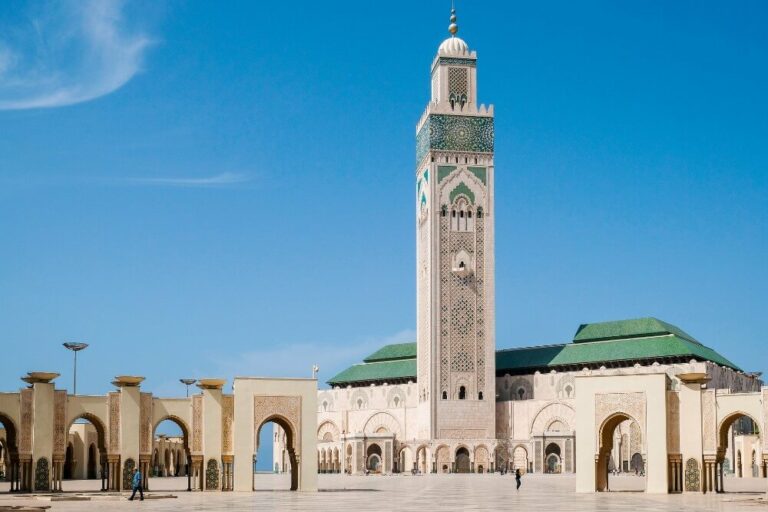Wandering through Casablanca’s lively streets, I was greeted by enticing scents that led me straight to the heart of the city’s food scene. Casablanca, a melting pot of flavors influenced by centuries of Moroccan history, serves up an array of dishes that are both delicious and deeply rooted in local tradition. The city abounds with culinary delights, from slow-cooked tagines to sweet pastries, each offering a taste of Casablanca’s rich gastronomic heritage.
So, what should you absolutely try when visiting? Let’s dive into the best local foods Casablanca has in store for us.
In the realm of savory meals, the tagine is king. This iconic Moroccan dish, named after the conical clay pot it’s cooked in, combines meat, vegetables, and a blend of spices like cumin, coriander, and cinnamon. The result is a tender, aromatic stew that’s a staple in Casablanca’s diet. Then there’s the beloved couscous, often enjoyed on Fridays, which is the local day of rest and family gatherings. It’s typically served with a delicious mix of stewed vegetables and sometimes lamb or chicken, all seasoned with a harmony of spices.
For those with a sweet tooth, Casablanca’s bakeries are treasure troves. A must-try is the cornes de gazelle, crescent-shaped pastries filled with almond paste and scented with orange blossom water. These delicate treats are a testament to the city’s Andalusian and Jewish influences.
Street food enthusiasts should not miss the chance to try b’ssara, a rich fava bean soup that’s both nourishing and comforting, especially during the cooler months. And for a quick bite, nothing beats a freshly made maakouda sandwich – a spicy potato fritter tucked into a crusty baguette.
Casablanca’s food reflects its history, culture, and the local love of good, hearty meals. It’s more than just eating; it’s an experience that connects you with the soul of the city. Whether you’re savoring a slow-cooked meal or biting into a sweet pastry, each dish offers a glimpse into the heart of Moroccan cuisine.
Tagines
In Casablanca, local cuisine is defined by its flavorsome tagines, central to Moroccan food culture. These dishes, named after the distinctive clay pots they’re cooked in, are renowned for their slow cooking technique which enhances the taste. With a range of ingredients including succulent meats such as lamb and chicken, as well as a selection of vegetables, tagines embody the diversity of Moroccan flavors, thanks to spices like saffron and cumin, and unique additions like preserved lemons and olives.
For example, the lamb tagine with apricots and almonds is a testament to the complexity of Moroccan culinary expertise. The tender lamb, when coupled with the sweetness of apricots and the texture of almonds, results in a dish that’s a feast for the senses. On the other hand, the vegetable tagine offers a hearty option for those who don’t eat meat, featuring a vibrant mix of vegetables like carrots and bell peppers, simmered in a rich tomato sauce, showcasing how the ingredients’ natural tastes are preserved.
Tagines represent the heart of Moroccan gastronomy. The meticulous slow cooking melds spices and ingredients together for a deeply satisfying and unique eating experience. When in Casablanca, indulging in a tagine isn’t just recommended, it’s essential for anyone looking to immerse themselves in the local food scene.
Couscous
Couscous truly captures the essence of Casablanca’s culinary heritage. This staple Moroccan dish is crafted from small semolina grains, meticulously steamed to a light and airy texture. The art of making couscous is a cherished practice within Moroccan tradition, handed down from generation to generation.
A beloved recipe for couscous features these grains combined with a medley of fresh vegetables such as carrots, zucchini, and onions, and includes either succulent lamb or chicken. This blend is then gently cooked in a couscoussier, a specialized pot designed for even steam distribution, ensuring that each grain is imbued with the savory flavors of the accompanying ingredients.
The final creation is a satisfying and fragrant meal. The couscous is exceptionally fluffy, complemented by the softness of the meat and vegetables. The distinctive blend of spices, including cumin, turmeric, and cinnamon, contributes a complex, authentic flavor that’s a hallmark of Moroccan culinary art.
More than just food, couscous represents a gesture of unity and festivity, often gracing the table at celebratory events and gatherings of loved ones. Preparing couscous is an act of dedication, demanding both time and careful attention. However, the outcome is a fulfilling experience that embodies the love and spirit of Moroccan culture.
Pastilla
Pastilla, a celebrated dish from Morocco, masterfully blends sweet and savory elements for a unique taste experience. Known also as B’stilla, it reflects the depth of Moroccan culinary practices. This dish is a proud display of Morocco’s rich food heritage.
The construction of Pastilla involves stacking layers of delicate, flaky pastry with a savory mix of either shredded chicken or pigeon, almonds, eggs, and a selection of spices like cinnamon and saffron. The pastry is then baked to achieve a perfect golden brown hue and a satisfying crispiness. A final sprinkle of powdered sugar and cinnamon on top provides a subtle sweetness that complements the savory interior.
What makes Pastilla particularly intriguing are its various iterations. While the classic recipe calls for chicken or pigeon, other versions exist, featuring seafood or plant-based alternatives, allowing for culinary innovation without losing the dish’s fundamental character.
Each bite of a freshly prepared Pastilla invites a reflection on the myriad of cultural influences that have contributed to Moroccan gastronomy. The nuanced flavor profile, the interplay of textures, and meticulous preparation are hallmarks of Morocco’s food culture. Pastilla stands out as a prime example of the harmony between sweet and savory that typifies Moroccan dishes.
Harira
Harira, a quintessential Moroccan soup, holds a special place in the hearts of locals and visitors alike. This nourishing and flavorful concoction is a year-round favorite, deeply embedded in the culinary heritage of Morocco. Here’s why everyone should try harira when in Casablanca:
Firstly, harira’s roots in Moroccan food culture run deep, symbolizing more than just sustenance. Centuries-old traditions see it grace the Iftar tables during Ramadan, providing not just nourishment but also a sense of unity among those who gather to share the meal. It’s a soup that embodies the communal spirit of Moroccan society.
Nutritionally, harira is a powerhouse. Laden with chickpeas, lentils, and tomatoes, this soup offers an abundance of proteins, fibers, and vital nutrients, making it an ideal meal for vegetarians seeking a fulfilling and balanced diet. The spices, including ginger, turmeric, and cinnamon, don’t just contribute to its signature taste; they also offer various health benefits.
Speaking of taste, each spoonful of harira presents a symphony of flavors. The spices merge to create a unique profile, with sweetness and a hint of spice, ensuring each bite is as satisfying as the last. It’s a testament to the rich and diverse Moroccan palate.
Moreover, harira’s adaptability is impressive. Traditional recipes often include meat, but plenty of vegetarian versions exist, replacing meat with more legumes or vegetables. This ensures the soup retains its robustness and appeal for those following a plant-based diet.
Seafood
In Casablanca, a city kissed by the Atlantic, seafood isn’t just food; it’s a testament to the city’s heritage and lifestyle. The local markets, alive with the hustle of fishermen hauling in their catch, offer an unrivaled selection of the ocean’s bounty. Freshness here isn’t a mere claim but a daily reality for both residents and tourists who seek the authentic flavors of the sea.
When discussing Casablanca’s seafood, it’s essential to highlight the Moroccan fish tagine – a cornerstone of culinary tradition. This dish, steeped in history, slow-cooks fish with spices, tomatoes, and vegetables in a clay pot known as a tagine. It’s a culinary process that not only cooks the fish but also marries it with the deep aromas of cumin, ginger, and saffron, resulting in a dish that’s tender to the fork and rich on the palate.
Grilled sardines are another local delight that shouldn’t be overlooked. Straight from the grill, these small fish are a big deal in Casablanca. Lightly seasoned with herbs and spices, they’re a prime example of how simple seasoning can elevate the natural, sweet flavors of seafood. The grilling process adds a subtle smokiness, creating a dish that’s straightforward yet utterly captivating.
These examples aren’t just meals; they’re an invitation to experience the heart of Casablanca’s culinary artistry. Each bite tells a story of the sea, the skill of the chefs, and the vibrancy of Moroccan culture.
Moroccan Pastries
Moroccan pastries are a feast for the senses, known for their fine layers, detailed patterns, and rich tastes. Integral to Moroccan food culture, these sweets are essential for anyone visiting Casablanca.
You should experience these four pastry varieties and the well-known shops where they’re available:
- M’hancha: Shaped like a serpent, this pastry encases a sweet mix of almonds, cinnamon, and the scent of orange blossom water. Pâtisserie Bennis Habous, famous for its genuine Moroccan desserts, is the ideal place to enjoy M’hancha.
- Chebakia: Resembling flowers, these pastries blend dough with sesame seeds, honey, and aromatic spices such as anise and cinnamon. Pâtisserie Bennis Habous and Pâtisserie Bennis Gauthier are known for serving the finest chebakia in Casablanca.
- Briouat: These crisp, triangular pastries come with various fillings including chicken, seafood, or sweet almond paste. For top-notch briouats, Pâtisserie Bennis Gauthier is a favored destination, known for their flavorful and perfectly textured treats.
- Gazelle horns: These pastries, mimicking the shape of a gazelle’s horns, are crafted with a fine almond filling and enhanced with the aroma of orange blossom water. To experience authentic gazelle horns that embody the essence of Moroccan pastry making, Pâtisserie Bennis Habous is the place to visit.
For those who love sweets or value culinary craftsmanship, exploring these traditional Moroccan recipes and visiting Casablanca’s esteemed pastry shops promises to be a memorable journey into the heart of Moroccan gastronomy.









